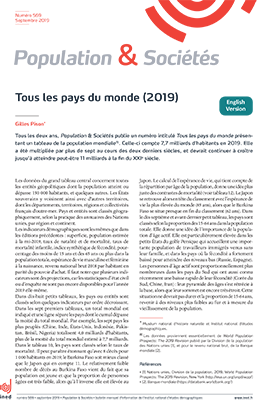The Population of the World (2019)
Press release Published on 09 September 2019
Population and Societies no. 569, September 2019

Author: Gilles PISON
Every other year, Population and Societies publishes a special issue called The Population of the World, presenting an overall picture of the situation across the globe. There were 7.7 billion humans on the planet in 2019. The world population has risen more than seven-fold over the last two hundred years and may well reach 11 billion by the end of the twenty-first century.
The world population is still growing. From 7.7 billion in 2019, it is forecast to approach 10 million by 2050. The pace of increase is slowing down, however. After peaking at 2% fifty years ago, annual growth has fallen by almost half (1.1% in 2019) and should continue to decrease until the population levels off at around 11 billion one century from now.
This slowdown is the consequence of declining fertility. Across the world today, women have 2.4 children on average, versus 5 in 1950. But this global average conceals large disparities across regions and countries. Fertility is lowest in South Korea (1.1 children per woman) and highest in Niger (6.8 children). In 2019, the world’s regions where fertility is still above 3 children include practically all of Africa, some countries of the Middle East and the regions extending from Afghanistan to Pakistan and northern India. These are the regions where world population growth will be concentrated in years to come.
One of the major changes in future decades will be the exceptional population growth in Africa. Despite the impact of AIDS, the continent’s population could almost quadruple by the end of this century, rising from 1.3 billion in 2019 to 4.3 billion in 2100. While one person in six currently lives in Africa, the proportion will probably be more than one in three one century from now. Growth will be especially strong in sub-Saharan Africa, where the population may increase nearly four-fold, from 1.1 to 3.8 billion, between 2019 and 2100.
With 1.43 million inhabitants, China is the world’s most populous country, although India, which is not far behind (1.37 billion), should take the lead before 2030 since its population is growing faster due to higher fertility (2.2 children per woman on average, versus 1.7 in China).
Please find attached the latest issue of Population & Societies (no. 569, September 2019), entitled “The Population of the World (2019)”
Link to the English version of Population & Societies no. 569, active from September 11, 2019:
https://www.ined.fr/en/publications/editions/population-and-societies/the-population-of-the-world-2019/
Released on: 11/09/2019








